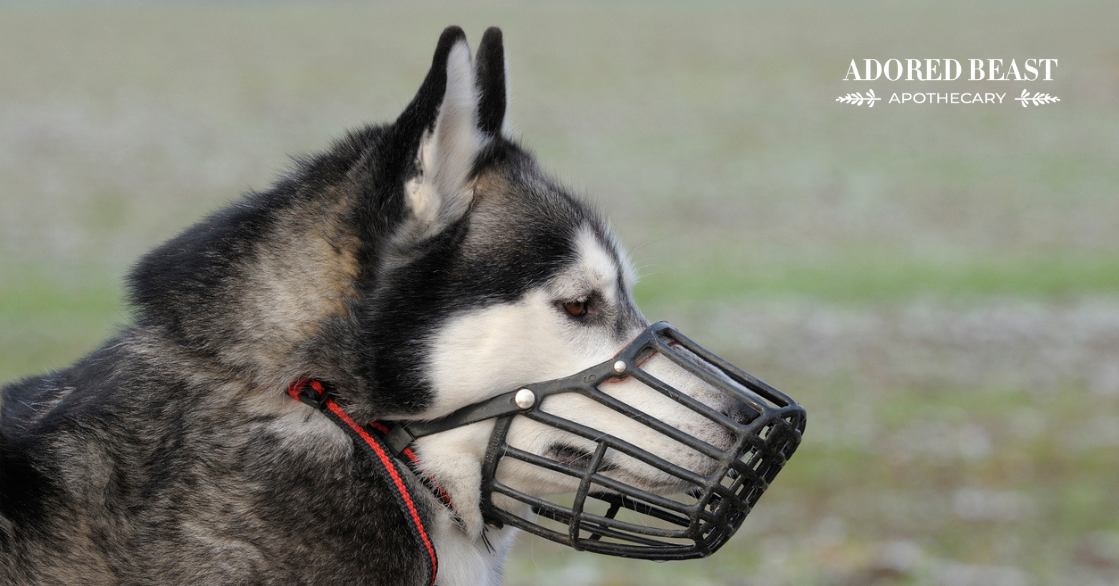One of our dogs, Indi, is a reactive dog. In certain situations and with certain triggers, she reacts (barks). As a German shepherd, the reactivity can be scary for people who don’t understand. Together, we are always working to help build her confidence, decrease her thresholds, and help her better cope – it may always be that way, and that’s ok. But we know her boundaries, and we respect them. And sometimes, to protect her and make others feel safe, she wears a muzzle.
When many people think of dog muzzles, they might picture an aggressive dog or a pet in distress. This misconception often leads to the belief that muzzles are inherently bad or a sign of poor behaviour. In reality, muzzles can be a valuable tool in various situations, helping dogs and their owners navigate the world safely and confidently. Indi is an incredibly smart dog, a snugglebug who loves her family and other dogs, but she has a bit of “stranger danger” so her muzzle helps in situations where closeness is unavoidable.
Here, we’ll explore the benefits of dog muzzles, common scenarios where they’re helpful, the different types available, and how to find the best fit for your furry friend.
Why Use a Muzzle?
Dog muzzles aren’t about punishment or labelling a dog as “bad.” Instead, they’re a proactive way to keep both dogs and humans safe. Here are some situations where muzzles can be particularly useful:
- Reactive Dogs: Dogs who are fearful, reactive, or nervous around other animals or people can benefit from wearing a muzzle. It provides an extra layer of security for everyone.
- Vet Visits: Even the most well-behaved dogs can become scared or defensive during medical exams. A muzzle can help ensure the safety of both your dog and the veterinary staff. This is one of the situations where Indi wears her muzzle.
- Dogs Who Eat Everything: If your dog has a habit of scavenging harmful objects like garbage, rocks, or toxic plants, a muzzle can prevent them from ingesting something dangerous during walks. This is especially helpful if you’re walking off-leash and can’t immediately stop them.
- Grooming Sessions: Some dogs become stressed or snappy during grooming, nail trims, or baths. A muzzle can make these experiences safer and less stressful for everyone involved.
- Public Safety: In crowded or unfamiliar environments, a muzzle can provide peace of mind, especially if your dog is unpredictable in high-stress situations.
That said, these are special situations. Muzzles should never be used as punishment, and they’re not a substitute for training. For example, if your pet chews stuff up in the house, a muzzle shouldn’t be used to stop them. That should be a training activity. They should only be used for short periods of time, and only while your dog is supervised.
Types of Dog Muzzles
There are several types of muzzles, each designed for specific uses. Choosing the right one depends on your dog’s needs and comfort:
- Basket Muzzles:
- Made of plastic, metal, leather, or rubber, basket muzzles allow your dog to pant, drink water, and even eat treats while wearing them. They look like little baskets that go over your pet’s snout.
- Best for longer wear, such as during walks or training sessions. They’re ideal if you use them when it’s warm, as panting is critical for temperature regulation, and basket muzzles don’t inhibit it.
- Soft Muzzles:
- Typically made of fabric or mesh, these muzzles fit snugly around the dog’s mouth. They’re more uncomfortable for your dog, as it restricts their mouth/jaw movement.
- Ideal only for short-term use, such as vet visits or grooming.
- Not suitable for extended wear as they can restrict panting. We would never recommend these for walks.
- Short-Snout Muzzles:
- Designed specifically for brachycephalic breeds like pugs and bulldogs.
- These muzzles fit their unique facial structure and provide a safe way to manage behaviour.
- Training Muzzles:
- Often adjustable and designed for training purposes, these muzzles can help with gradual desensitization. With these, we recommend working with a trainer.
Finding the Best Fit
A properly fitted muzzle ensures comfort and effectiveness. You don’t want it to fall off or for your dog to be able to wiggle out of it. You also don’t want it to be too tight and hurt them. Here’s how to find the right fit:
- Measure Your Dog: Use a soft measuring tape to determine the circumference and length of your dog’s snout. Refer to the sizing guide provided by the muzzle manufacturer.
- Comfort First: Look for muzzles with padded edges to prevent chafing. Adjustable straps can help achieve a secure yet comfortable fit.
- Breathability: Ensure the muzzle allows your dog to pant and drink water, especially for extended wear.
[RELATED] Crates are another valuable tool that are sometimes misunderstood. Here’s how to use them.
How to Get Your Dog Used to a Muzzle
When we first got Indi her muzzle, we went really, really slow to get her used to it. We didn’t want it to ever feel like a punishment or for it to add to her anxiety. Introducing your dog to a muzzle should be a gradual and positive process. Take it step by step – don’t rush it.
Start by letting your dog sniff and explore the muzzle without putting it on. Reward them with treats and praise to create a positive association. Next, try holding the muzzle and placing treats inside it, encouraging your dog to voluntarily place their nose inside. Once they’re comfortable with this, gently fasten the straps for a few seconds while continuing to reward them. Gradually increase the time they wear the muzzle, always making it a rewarding and stress-free experience. Try not to force it. if, at any point, it feels like they’re getting nervous, slow right down again. They may never learn to “love” it, but you can help them get comfortable with it.
Dog muzzles are a practical tool that can make life safer and less stressful for you and your dog. Far from being a sign of failure, using a muzzle demonstrates responsible pet ownership and a commitment to your dog’s well-being. By understanding when and how to use a muzzle, as well as choosing the right type and fit, you can help your dog thrive in situations that might otherwise be overwhelming. Just remember, a muzzle isn’t a substitute for training or addressing behavioural issues – it’s just one piece of the puzzle in helping your dog live their best life.












